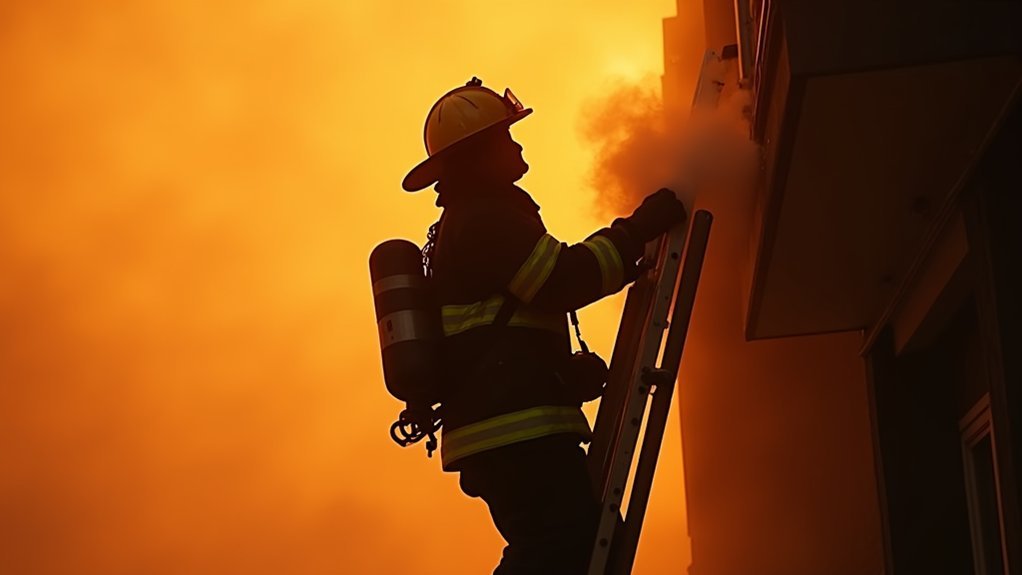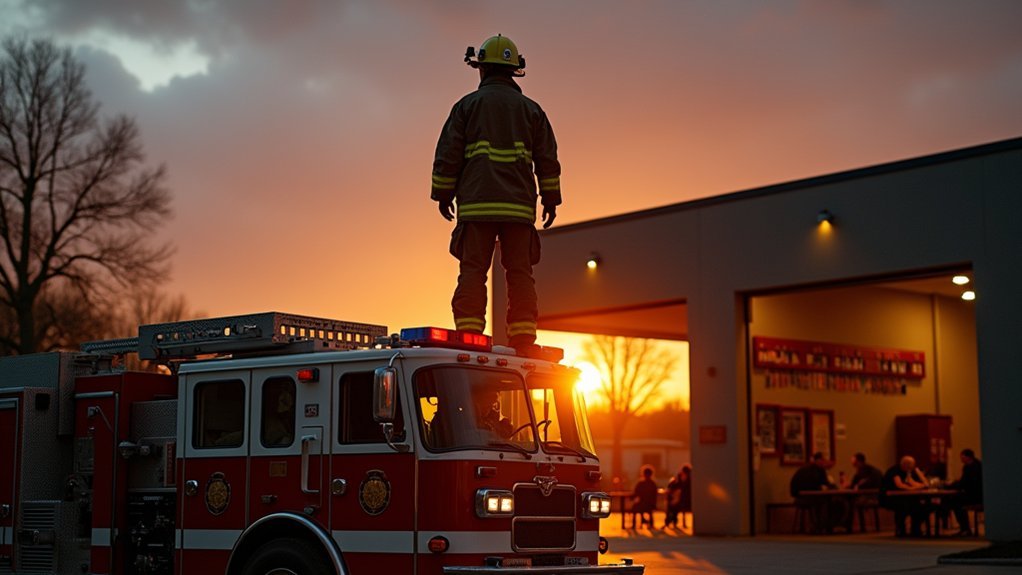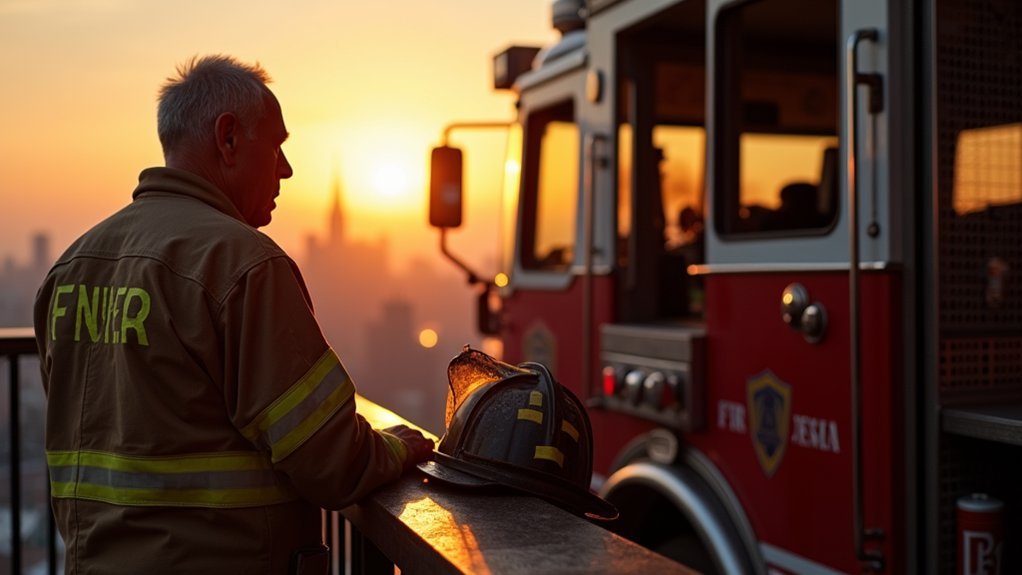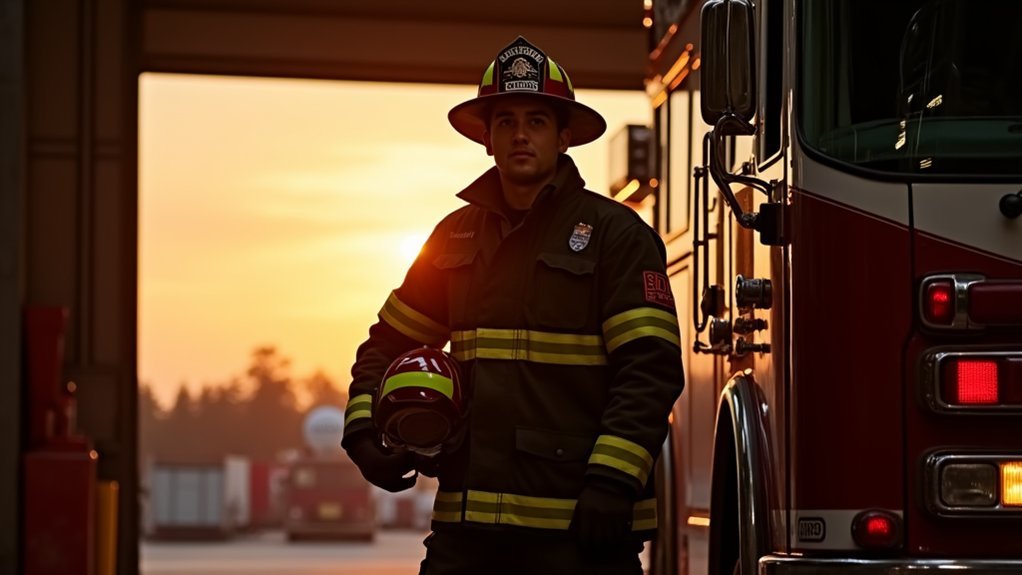A firefighting career is a fulfilling path for those committed to public service, offering a mix of physical challenges and mental demands. With robust training, firefighters guarantee public safety as they earn a competitive salary. Though it faces challenges like high turnover and emotional strain, support systems are in place to aid resilience. The field is competitive, but growth opportunities exist. For those keen to impact their communities, exploring this career further reveals its potential rewards.
Key Takeaways
- Firefighting offers competitive compensation and strong job security due to high demand and community importance.
- The profession requires rigorous physical and mental preparation, along with continuous learning and problem-solving skills.
- Career advancement opportunities exist, including leadership roles and specialization in areas like risk management.
- Resilience and mental health resources are essential to handle the emotional and physical demands of the job.
- The satisfaction from community service and teamwork contributes to overall job fulfillment and purpose.
Is Firefighter a Good Career Path? Let's Explore

A career as a firefighter involves a commitment to public safety and requires a strong sense of duty and skill. Firefighters undergo rigorous training, including physical fitness tests and acquiring certifications like EMT, which equip them to handle emergencies effectively. The job is both mentally demanding and physically challenging, requiring constant adaptability and resilience. In spite of the inherent dangers and competitive nature of the field, many find the role rewarding because of the opportunity to serve the community and the potential for career advancement. The profession continues to grow, with approximately 26,400 annual openings due to transfers and retirements, providing plenty of opportunities for new entrants into the field.
What does a career in Firefighter involve?
A career as a firefighter involves a range of important responsibilities, such as quickly responding to emergencies, operating fire trucks and specialized equipment, and conducting search and rescue operations. Success in this field requires key skills including physical fitness, strong communication, and the ability to make quick decisions in high-pressure situations. Effective Stress Management Skills are also crucial for firefighters to cope with the physical and emotional demands of their job. In addition to these capabilities, firefighters often collaborate with Police Officers on fire-related incidents to assist in investigations. Firefighters must additionally possess basic life support certifications and technical expertise in handling complex equipment to effectively manage the varied challenges they face. Before establishing their presence on the field, firefighters must also undergo extensive training classes and drills to ensure they are well-prepared for the demands of their role.
Common responsibilities in Firefighter
Firefighters hold critical responsibilities that are crucial to public safety and emergency response. They collaborate efficiently in firefighter teamwork to tackle fires, medical emergencies, and hazardous situations. Enacting emergency response protocols, they skillfully use tools for vehicle extrications and rescues. Furthermore, they administer life support, conduct inspections for fire risks, and maintain equipment. Community engagement, including fire safety education, further emphasizes their indispensable role. Under the direct supervision by the Fire Chief, they assist in both emergency and non-emergency operations related to fire and medical services.
Required skills for success
Success in a firefighting career hinges on a diverse set of skills that secure competence and reliability in high-pressure situations. Effective communication and problem-solving abilities are essential. Firefighter mentorship nurtures growth, whereas community engagement builds trust. Physical fitness, adaptability, and teamwork guarantee operational efficiency. It is crucial to maintain proficiency in putting on protective equipment, as firefighters must be able to do so in under a minute. Mechanical aptitude and integrity are crucial, along with continuous learning and stress management to handle evolving challenges effectively. Upholding a legacy of trust established by previous firefighters is vital for maintaining the reputation and trust of the service.
Is There Demand for Firefighter Professionals?
The demand for firefighters is shaped by changing industry trends and a steady job market outlook, with employment expected to grow by 4% from 2022 to 2032. Entry-level firefighters undergo a few months of training at fire academies, which equips them with essential skills. Regions such as Texas, California, and Florida exhibit high demand because of growing communities and infrastructure development. As firefighter roles evolve to include more emergency medical responses, advancements in technology and safety continue to play an essential role in determining career opportunities and challenges.
Industry trends shaping Firefighter careers
Today's swiftly changing technological environment greatly affects the firefighting industry, revealing a variety of promising trends shaping the career outlook for these vital professionals. Among the most notable are firefighter innovations, such as AI-powered fire detection systems that improve early warning capabilities, making firefighting operations more efficient. Additionally, sustainable practices are gaining prominence, with the adoption of eco-friendly fire suppression agents that reduce the environmental impact of firefighting efforts. The integration of IoT devices into interconnected safety networks further enhances emergency response coordination, demonstrating a commitment to modernized and efficient practices. Insight from the Annual What Firefighters Want survey will contribute toward aligning fire department tactics and policies with modern technologies. Firefighter tape, specifically designed to withstand high temperatures and harsh conditions, is another innovation enhancing safety and effectiveness in rescue efforts. Advanced training methods now incorporate state-of-the-art technologies, boosting the skill development of firefighters. These trends underline a forward-thinking shift, improving both operational effectiveness and environmental responsibility within the firefighting profession.
Job market outlook for Firefighter
One significant aspect of the firefighting profession today is comprehension of the job market outlook, which shows both challenges and opportunities for aspiring firefighters.
The U.S. Bureau of Labor Statistics projects a steady 4% growth in firefighter employment from 2022 to 2032, reflecting a stable career path. Emerging demand is fueled by retirements, community expansion, and population growth. Firefighter/paramedic jobs are in demand, with a projected growth rate of 7% from 2018 to 2028, indicating an increasing number of job opportunities in this area. However, despite this growth, highly sought applicants often outnumber the available positions, making the field competitive, especially in more populated regions.
Job satisfaction and firefighter culture are critical elements, as both influence recruitment and retention. Firefighting roles increasingly necessitate multi-skilled individuals, often requiring EMT certifications, enhancing competitiveness and demand within the field. Physical conditioning, similar to that required in Muay Thai training, is also essential for firefighters to perform their duties effectively.
- Annual openings: approximately 26,400, mainly from retirements.
- Projected new positions: 12,000 over the decade.
- Moderate employment opportunities overall.
- Competitive environment with more applicants than positions.
- Departments expand as cities grow, offering advancement.
Benefits of Working in Firefighter

Many people choose a career as a firefighter because of the competitive compensation and job security that the profession offers. Firefighters benefit from a dynamic work environment and the personal fulfillment associated with helping others in emergency situations. The unwavering job security in firefighting provides peace of mind in financial uncertainty. Furthermore, the career provides opportunities for advancement and the development of transferable skills that are valuable in various professional contexts.
Why people choose Firefighter as a career
A career as a firefighter offers several appealing benefits that attract many individuals to this essential profession. Key advantages include job security, as firefighters are consistently in demand and benefit from economic resilience, in addition to competitive compensation packages like robust healthcare and retirement benefits. Furthermore, firefighters are driven by a strong interest in serving their communities, which enhances their job satisfaction and sense of purpose. Additionally, firefighters enjoy a flexible work schedule, such as options for 24-hour shifts followed by 48 hours off, allowing them to maintain a balance between career and personal life. Moreover, the profession provides long-term growth potential through various career advancement opportunities such as progressing to leadership roles or specializing in different areas, ensuring both personal fulfillment and professional development. Those interested in personal training may also find some overlap with firefighting, particularly in the area of physical fitness requirements.
Key advantages of working in Firefighter
As the decision to become a firefighter can be guided by multiple factors, the key advantages of working in this field often draw many individuals to the profession.
Firefighters benefit from thorough training programs and active community engagement, which enrich their professional and personal lives. Moreover, they enjoy several perks:
- Competitive salaries
- Extensive health insurance
- Consistent job security
- Strong teamwork
- Leadership development opportunities
Financial benefits ensure sustainable support for firefighters and families, providing them with job satisfaction and retention through comprehensive compensation packages.
Long-term growth potential
Firefighting attracts individuals for reasons that extend beyond immediate benefits, offering a strong potential for long-term career growth.
The profession is expected to see a 4% employment increase by 2032, aligning with average job growth rates. This demand stems from consistent community needs for emergency services.
Career advancement opportunities, including leadership roles and specialization, provide long-term benefits, contributing to the appeal of firefighting as a career choice.
Challenges of a Career in Firefighter
A career in firefighting presents several challenges that can impact both personal and professional aspects of life. Staffing issues, including mandatory overtime and inadequate response rates, often strain the workforce and affect service delivery. Moreover, high employee turnover disrupts safety and services, underscoring the importance of maintaining a supportive work environment. Furthermore, urban departments tend to face more acute staffing challenges compared to rural counterparts, which adds to the complexity of maintaining consistent service standards. Moreover, the physical and emotional demands of the job, such as exposure to traumatic events and the need for high physiological endurance, underscore the necessity for thorough mental health support within the profession. Increasing emergency call volumes place greater demands on existing staff, compounding the pressure firefighters face on a daily basis. Emotional intelligence training can also help alleviate stress and promote a more empathetic work environment by fostering effective communication.
Common difficulties in Firefighter
Entering the firefighting career presents several barriers, primarily because of its highly competitive nature.
Prospective firefighters face rigorous physical tests, challenging exams, and a limited number of available positions, meaning that merely a select few can secure a job.
The competition is intensified by the declining number of volunteer firefighters, increasing the pressure on career seekers to not just meet but exceed the demanding entry requirements.
Barriers to entering Firefighter
Whilst a career in firefighting holds significant appeal for many, several barriers can hinder entry into the profession.
Firefighter stereotypes and recruitment strategies play a role. Misconceptions and limited awareness deter interest. Moreover, becoming a firefighter typically requires attendance at a firefighter academy, which can be a demanding commitment for prospective candidates.
Furthermore, informal recruitment methods perpetuate a lack of diversity. Generational priorities further complicate recruitment efforts by challenging the traditional fire service culture.
- Misleading stereotypes
- Traditional hiring practices
- Limited awareness
- Generational differences
- Homogenous recruitment methods
How competitive is the job market?
How competitive is the firefighter job market, given the high interest it attracts? The number of applicants often exceeds available positions, creating an intense environment.
To succeed, job applicants should focus on strategies like acquiring paramedic training and maintaining high physical scores.
Firefighter recruitment trends indicate a stable demand for skilled individuals, with annual job openings driven by retirements and transfers in spite of modest growth.
How to Start a Career in Firefighter

Starting a career as a firefighter involves meeting specific educational and training requirements.
A high school diploma or GED is crucial, with additional training in fire science and obtaining EMT certification highly recommended.
Prospective firefighters can gain valuable experience by volunteering, staying physically fit, and attending a fire academy to improve their skills and readiness for this demanding role.
Education and training requirements
Becoming a firefighter requires specific certifications that demonstrate readiness and competence in the field.
Prospective firefighters often pursue an EMT certification as it is highly valued and sometimes mandatory by fire departments.
Moreover, fire academy training, followed by certifications in fire science, can greatly enhance a candidate's employability and set a solid foundation for a successful career in firefighting.
Recommended certifications for Firefighter
For those considering a career as a firefighter, acquiring a set of recommended certifications is vital to getting started in this field.
Certification pathways and advanced training are important for both skill development and career progression. Basic and advanced certifications like Firefighter I, Firefighter II, EMT, and others set the foundation.
- Firefighter I & II
- Basic Life Support (BLS)
- EMT Certification
- Pro-Board Accreditation
- Rescue Technician
How to gain experience in Firefighter
Starting a career as a firefighter often begins with meeting basic qualifications and gaining practical experience. Potential candidates should start by securing internships or joining mentorship programs, which can offer firsthand exposure to the field.
Beyond age (typically 18 or older) and a high school diploma, aspiring firefighters should focus on improving physical fitness to pass ability tests like the CPAT. Gaining hands-on experience through volunteer opportunities is valuable, as is visiting local fire stations for insights and networking.
Cadet programs provide foundational training for younger individuals, whereas studying fire science can deepen comprehension. Acquiring additional certifications, such as EMT training, further upgrades job prospects, solidifying the requisite skills and knowledge to commence on this challenging yet rewarding career path.
Salary & Career Growth in Firefighter
Firefighters in the United States earn a range of salaries, with averages reflecting variations based on state and city locations, along with factors like experience and certifications.
Career advancement opportunities are available, offering pathways to higher-ranking positions such as engineer or captain, provided individuals gain necessary experience and training.
In spite of competition in the field, the projected job growth and potential for advancement indicate a stable career path for those pursuing this essential public service role.
Average salary for Firefighter professionals
The career of a firefighter offers a varied salary range, largely influenced by factors such as location and experience. Salary comparisons reveal noticeable regional differences, with some states and cities offering higher compensation than others.
The national median salary stood at $57,120 in May 2023, though some figures suggest an average of $44,441 per year. Experience greatly impacts salaries, with more seasoned firefighters earning more, and top earners making up to $93,790 annually.
Geography likewise plays a vital role, as different states show different median salaries. Variability in earnings emphasizes the importance of considering both certifications, like EMT, and experience levels.
The following points highlight key aspects:
- National median salary: $57,120
- Average salary: $44,441
- Top 10% earners: $93,790
- Location impact
- Experience influence
Career advancement opportunities in Firefighter
For those pursuing career advancement within the fire service, a structured path often begins with entry-level roles and advances through various ranks like Crew Manager and Watch Manager.
Professionals aiming to climb the ladder benefit from enhancing fire service leadership capabilities, acquiring strategic planning skills, and obtaining firefighting certifications.
Advancement opportunities are competitive, necessitating continuous education and a commitment to performance excellence.
Specialization in areas such as fire safety or risk management can broaden prospects.
Programs in mentorship and networking facilitate career growth by connecting with seasoned professionals.
Pursuing higher education degrees in fields like fire science or public administration can lead to improved roles.
As the industry evolves with technology, those prepared with relevant skills will find opportunities for progression.
Is Firefighter a Good Career Path? Final Thoughts

Choosing a career as a firefighter offers the satisfaction of making a significant impact on community safety whilst experiencing the camaraderie unique to this line of work.
Nevertheless, prospective firefighters need to reflect on the rigorous physical demands, necessary training, and competitive nature of entry into the field.
With steady job prospects and opportunities for advancement, the role can be fulfilling, but applicants must be prepared for the challenges and commitments it entails.
Key takeaways for choosing Firefighter as a career
How might one determine if a career as a firefighter is the right path? An individual might consider both career fulfillment and community service.
Firefighters often find purpose and satisfaction by considerably impacting their communities and saving lives. The role offers both responsibility and opportunities for recognition within the community.
Firefighters benefit from a diversity of tasks and the crucial camaraderie developed within teams. Additionally, the career provides stability and security.
To succeed in this role and effectively share experiences with others, firefighters can benefit from mastering vocal variety and tone.
To summarize, consider these key points:
- High career fulfillment through direct community impact.
- Variety in daily activities, from emergencies to prevention.
- Strong teamwork and bonds improve job satisfaction.
- Long-term stability and job security in firefighting roles.
- Opportunities to serve the community and seek recognition.
Thus, choosing this path might align with one's desire for meaningful work.
Factors to consider before starting in Firefighter
When evaluating a career as a firefighter, several significant factors warrant careful consideration.
Physical demands are considerable, requiring strength and endurance for tasks like hauling hoses and climbing ladders. Regular training and certifications, such as EMT and CPR, are essential, often facilitated through volunteer opportunities.
Mental resilience is important to handle stressful situations. Exploring job shadowing provides insights into the demands of the job and helps assess personal fit.
Firefighters must adapt to irregular work schedules and potential overtime, impacting family and social life. Additionally, considering health risks, including potential injuries and mental health challenges, is critical.
In spite of these challenges, the career offers satisfying service to the community, strong job satisfaction, and potential benefits, advocating for thorough evaluation before initiating this career path. Embracing setbacks and building resilience is crucial for firefighters to maintain their mental and emotional well-being throughout their careers.
Frequently Asked Questions
What Are the Educational Requirements to Become a Firefighter?
To become a firefighter, one must complete high school or a GED, undergo firefighter training, and participate in certification programs. Advanced education in fire science, EMT training, and specialized certifications improve job prospects and career advancement.
How Physically Demanding Is the Job of a Firefighter?
Firefighting demands exceptional physical fitness, rigorous endurance training, and strong cardiovascular health. With tasks requiring significant strength and determination, firefighters face intense physical challenges that necessitate peak aerobic capacity and resilience for effective performance and safety.
Are There Opportunities for Specialized Roles Within the Firefighter Field?
In the firefighter field, specialized roles offer extensive specialized training and advancement opportunities. Roles such as paramedics, rescue technicians, and fire investigators require continuous education, promoting career growth, skill diversification, and the ability to plunge into complex emergencies effectively.
What Is the Average Age of Retirement for Firefighters?
Coincidentally, retirement benefits and pension plans coincide with the average retirement age for firefighters, which typically falls between 52 and 57. Jurisdiction variability and job demand nuances play pivotal roles in determining their retirement timing.
What Kind of Work-Life Balance Do Firefighters Typically Have?
Firefighters often face challenges in maintaining work-life balance as a result of irregular shift schedules and on-call requirements. Nevertheless, strong family support and camaraderie among peers can mitigate stress, contributing to a healthier personal and professional life.
Conclusion
To sum up, a career as a firefighter offers both significant rewards and challenges. With a projected job growth of 4% from 2019 to 2029, according to the U.S. Bureau of Labor Statistics, the demand for firefighters remains steady. The role provides a sense of purpose and community service, though it requires physical stamina and can involve high-stress situations. For those committed to public safety, firefighting represents an opportunity to make a meaningful impact in society.
